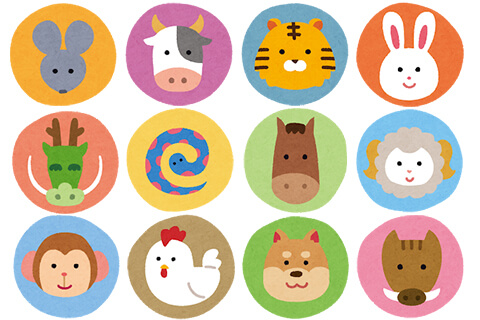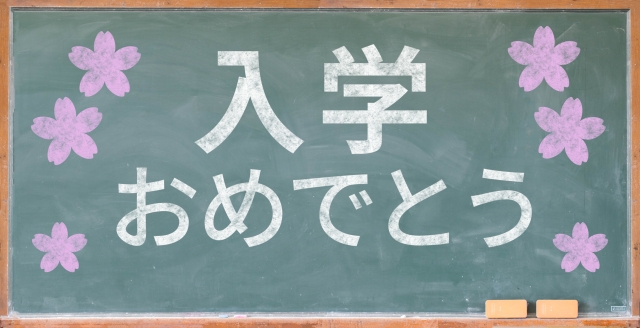Eto
Eto is a zodiac animal that forms a 12-year cycle. From November to December, next year’s animals will begin to appear in various seasonal products sold in New Year’s cards and in Japan.
From mouse to wild boar
The idea of animals in the zodiac, which represent different years with a 12-year cycle, originally came from China. The first system to appear was a set of simple kanji representing 12 numbers. Originally used to calculate the number of years, it was later used to indicate the time zone and the direction of the compass, and was also used for fortune-telling. Eventually, a set of 12 animals was associated with the cycle.

Click here to learn Japanese language with the best one-on-one Japanese tutoring lessons in person or online.
12 ets drawn in order on the ceiling of the main gate of Tenmangu in Osaka.
Zodiac animals vary slightly from Asian country to country. In Japan, called Eto, it is made up of rats, cows, tigers, lions, dragons, snakes, horses, sheep, monkeys, roosters, dogs, and wild boars. Illustrations and photos of 12 animals are posted on New Year’s cards and calendars.
Fortune-tellers predict what will happen in the year based on Eto, and some believe that personality is related to the beast of the year of birth. For example, 2017 was said to be good for business because it leads to prosperity. On the other hand, babies born in 2018, the year of dogs, will grow loyally and sociably according to these beliefs.
From November to December, the Japanese look forward to next year and buy New Year’s cards and stamps decorated with the corresponding animal designs. The custom of sending postcards and letters during the New Year has replaced the previous tradition of visiting the neighborhood. During the first few days of January, during the New Year, many people visit shrines and temples for the first visit of the year, the first visit to the shrines and temples, and wish them good luck for the next 12 months. This usually means writing a wish on a wooden ema tablet, which often has a picture of the animal of the year on one side. The festive chopsticks used earlier this year may be in a special Eto-designed bag.
Earthenware bells in the shape of Eto animals are a traditional attraction to bad luck. These bells are traditional purchases for the New Year holidays. Different regions boast their own local designs.
12 Eto is often a motif of popular culture, such as Natsuki Takaya’s “Furutsubasuket” and Nishio Ishin’s novel “Juni Taisen”. The long-standing cartoon Naruto by Masashi Kishimoto also featured 12 guardian ninjas, each associated with a different zodiac animal.
When you visit Tokyo Station, you can see eight ethos carved on the ceiling of the octagonal dome at the north exit of Marunouchi. They are made of fiberglass reinforced gypsum and oppose the gray-green background. It was a mystery that four animals went missing for years. After that, in 2013, the remaining Edo was discovered during the renovation work of the pylon of Takeo Onsen, Saga Prefecture, the hometown of Tatsuno Kongo, the designer of the Tokyo station building.
干支
干支は12年周期の干支の動物です。11月から12月頃になると、年賀状や季節の商品が店頭に並ぶようになります。
ネズミからイノシシへ
12年周期で異なる年を表す干支の動物のアイデアは、もともと中国から来ています。最初に登場したのは、12の数字を表す簡単な漢字のセットでした。元々は年を計るために使われていましたが、後に時間や方位を表すために使われるようになり、占いにも使われるようになりました。やがて、十数匹の動物の集合体がこのサイクルに関連するようになりました。
大阪の天満宮の表門の天井には、12匹の干支が順番に描かれています。
干支の動物は、アジアの国々によって少しずつ違いがあります。干支と呼ばれる日本では、ネズミ、ウシ、トラ、ウサギ、ドラゴン、ヘビ、ウマ、ヒツジ、サル、オンドリ、イヌ、イノシシで構成されています。年賀状やカレンダーには、この12匹の動物のイラストや写真が描かれています。
占い師はエトをもとにその年の出来事を予測しますが、生まれた年の獣と性格が関係していると考える人もいます。例えば、2017年は酉が繁栄と結びついていることから、商売に良いと言われていました。一方、戌年である2018年に生まれた赤ちゃんは、これらの信仰に基づいて、忠実で社交的な性格に育つとされています。
11月、12月になると、日本人は年賀状や切手を買い求め、その年に対応する動物の絵柄が描かれた年賀状や切手を購入して、次の年を迎えます。年賀状や切手を買うのは、それまでのお参りの習慣に代わって、お正月にはがきや手紙を送る習慣が定着してきました。正月の最初の数日間は、多くの人が初詣と称して神社やお寺に初詣に行き、12ヶ月間の幸運を祈る。絵馬板に願い事を書くのが一般的で、片面にはその年の動物の絵が描かれていることが多い。また、年明けに使用する祝い箸「岩井橋」は、「干支」をデザインした専用の袋に入っていることもあります。
干支の動物の形をした土鈴は、厄除けの伝統的なお守りです。年末年始に購入する伝統的なお守りです。地域によってデザインが異なります。
12 干支は、夏木隆也の『古都ばすけっと』や二代目イシンの『十二大戦』など、ポピュラーカルチャーの中でも頻繁に登場するモチーフである。また、岸本斉史の「NARUTO-ナルト-」では、干支の異なる動物にちなんだ12人の忍者が登場しました。
東京駅丸の内北口の八角ドームの天井には、8体の干支が彫刻されている。灰緑色の背景に、ガラス繊維強化石膏で作られた8体の干支が立っている。なぜ4頭が行方不明になったのかは長年謎だった。そして2013年、東京駅ビルの設計者である辰野金吾氏の故郷である佐賀県武雄温泉のタワーゲートの改修工事中に、残りの干支が発見されたのです。
東京駅丸の内北口の天井。よく見ると、灰緑色の背景に干支の動物の彫刻が。
12の干支とその縁起物
漢字読み絵文字
2008 子ね 🐀 子孫の豊饒と繁栄
2009年 丑 丑 丑 🐄 根気と誠意
2010 寅寅 🐯 決断力と知性
2011年 卯 u 🐇 家族の幸福と快進撃
2012年 辰辰 🐉 正義感と権力感
2013年 巳巳 mi 🐍 探究心・情熱・再生の感覚
2014年 午 uma 🐎 明るさと柔軟性
2015 未 ひつじ 🐑 家族の幸福と平和
2016 申さる 🐒 知恵と知性
2017年 酉 TORI 🐓 ポジティブと商売繁盛
2018 戌 いぬ 🐶 献身性と社交性
2019年 亥 i 🐗 健康










